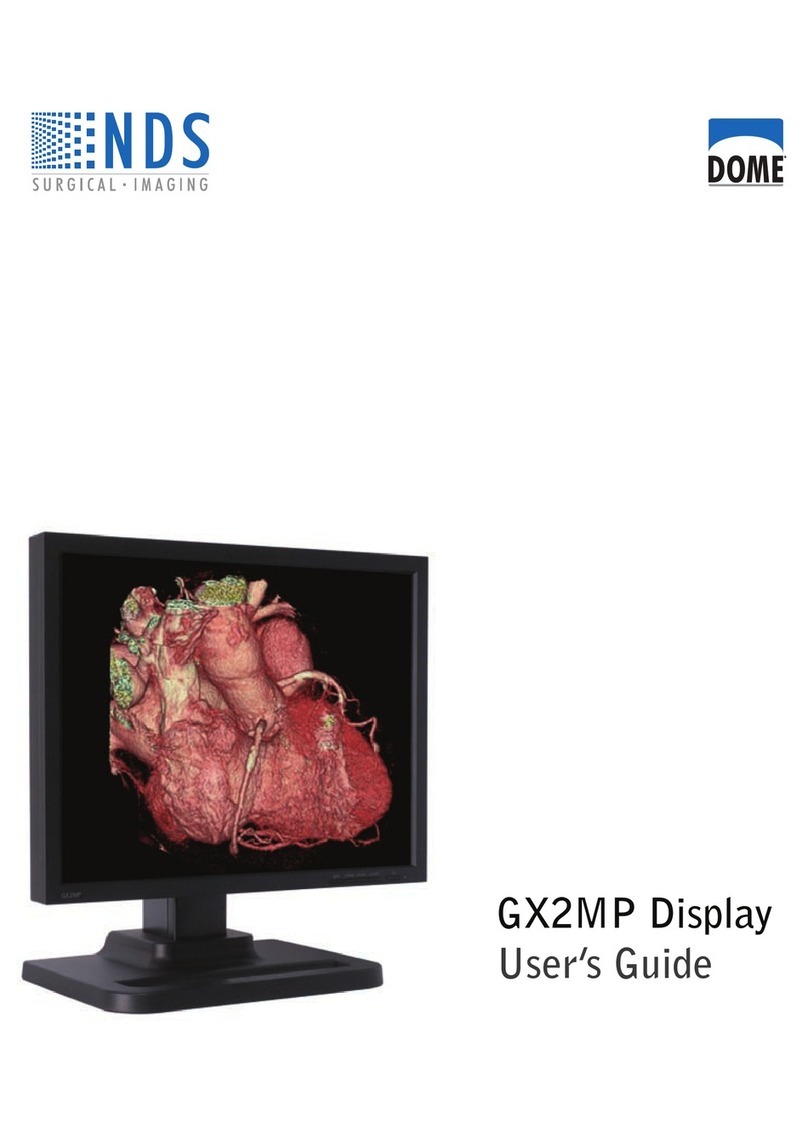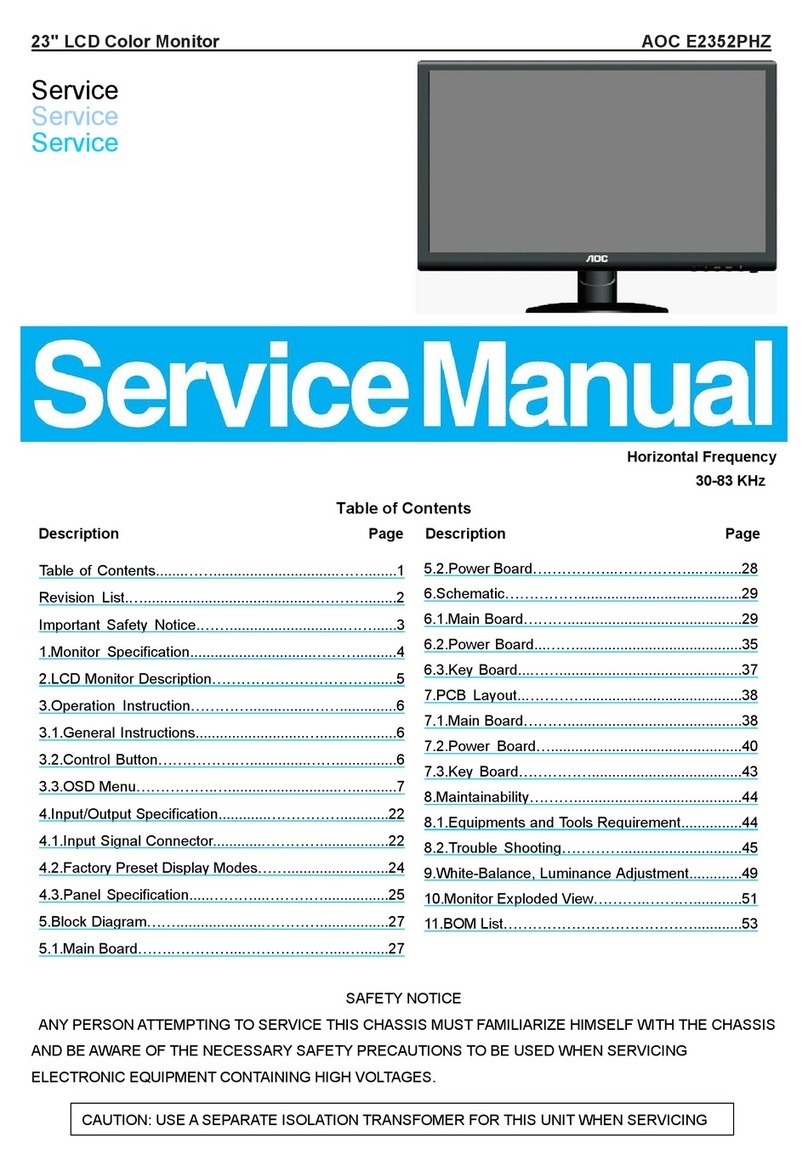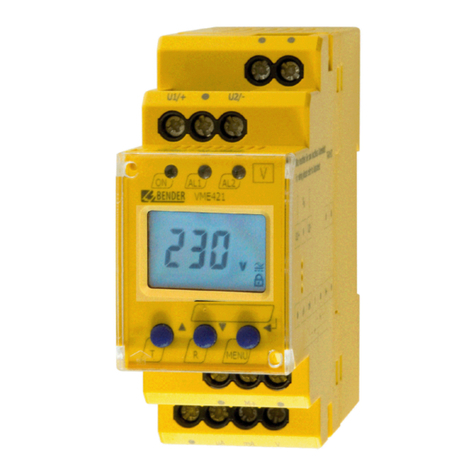Altronic DD-40NTS-O User manual

-1-
DIGITAL ANNUNCIATOR INSTALLATION INSTRUCTIONS
DD-40NTS-O, DD-40NTS-U DD-NTS II 5-02
WARNING: READ THESE INSTRUCTIONS CAREFULLY BEFORE INSTALLING OR
OPERATING THE DD ANNUNCIATOR SYSTEM. AN IMPROPERLY INSTALLED OR
OPERATING DEVICE MAY RESULT IN AN UNSAFE OPERATING CONDITION OF THE
MONITORED MACHINE WHICH CONSEQUENTLY COULD POSE THE THREAT OF
PERSONAL INJURY TO OPERATORS OR OTHER NEARBY PERSONNEL.
1.0 DESCRIPTION
1.1 The Altronic DD-40NTS digital annunciator is an electronic, 40-point monitor and shutdown
device. The annunciator hasa built-in hourmeter / tachometer with over speed protection.
A front mounted keypad serves as a user interface along with a LCD display.
1.2 The DD-40NTS annunciator system is suitable for use in Class I, Group C or D, Division 2
hazardous locations and consists of the following items:
DD-40NTS-O Annunciator, 40 normally open points
DD-40NTS-U Annunciator, 40 normally closed or open points (can be mixed)
(requires terminal module part no. 672169-1)
691200-1 Power Supply- 10 to 30 Vdc, 50 mA max. or 100 to 400volt negative ground
CD ignition systems.
693115-1 Cable, DB-25 (2 required for DD-40NTS-U unit only)
693116-1 Cable, DB-9 (for RS-232 serial communications)
1.3 RS-232 / RS-485 serial communications are provided for remote engine monitoring via
modem or satellite. Serial communications require the use of the DC power option.
1.4 For reliable operation, the following instructions must be adhered to strictly.
2.0 MOUNTING
2.1 ANNUNCIATOR UNIT - Using four #10 screws, mount the Annunciator Unit inside a control
panel or to a suitable flat surface so that the display is at a convenient viewing height. A
drilling template is provided. The annunciator unit box must be grounded.
NOTE: Avoid mounting with the LCD display facing direct sunlight. The display
temperature range is -40°F. to +175°F.
2.2 691200-1 POWER SUPPLY - The Power Supply mounts directly to the back of the
Annunciator Unit using two 8-32 x 5/16" length screws provided.
2.3 The terminal strip board (onlyapplicable on the -Uversion) can be snapped on 32 or35 mm
DIN mounting rails.

-2-
3.0 WIRING (SEE WIRING DIAGRAMS)
3.1 The annunciator unit plugs into the power supply through a DB-9 connector.
3.2 The sensor leads connect to the removable terminal strips on the back of the annunciator.
These terminal strips match those used with the earlier DD-40NT / DD-20NT systems.
3.3 At the terminal strip of the Annunciator unit, strip the insulation back 3/8"; twist the exposed
wires tightly together. Insert the exposed wire end completely into the terminal strip and
securely tighten the clamping screw. It is suggested that wire 18 AWG (max.) to 24 AWG
(min.) be used for the connections directly to the annunciator terminal strip connector.
3.4 Wires runningto thevarioussensors should be in goodcondition or replacedwithnew wiring.
Terminationstothemainpanelterminalstrip(ifused) should bemadewith asuitableterminal
and crimping tool or by soldering. There is no requirement for explosion-proof conduit or
Class I enclosures; however, suitable physical protection should be provided.
CAUTION:
a.) SENSOR WIRING: Sensor wires within the panel enclosure must be kept at least two
(2) inches from other wiring. Use a separate junction box for ignition and fuel valve
wires. Runsensorleads leavingthepanelinaconduitseparatefromallotherwiringand
keep separate throughout the installation. Wiring to the sensors must have a grade of
insulationcapable of withstanding an AC voltage of 500V. RMS. Sensor leads may be
connectedtoanypassivedeviceusingcontactssuchasstandardswitchgauges orlevel
switches. DO NOT connect sensor leads to relay contacts or to any voltage producing
element.
b.) Sensors will be exposed to much lower voltages and current than with the standard
Murphytattletale orsimilar type system. Inthe caseofa fieldconversionwhere sensors
have previously been used with Murphy tattletales, it is recommendedthat the sensors
be checked frequently when the DD system is first put into use. Sensor contacts may
beburnedorpitted frompastexposure to ignitionsystem primaryvoltage.It isadvisable
to replace such sensors.
c.) If it becomes necessary to check sensor to panel wiring with an ohmmeter or other
checker, firstDISCONNECTtheplug-interminalstripsfromtheback of the Annunciator
Unit. Applying voltage to the annunciator through the sensor leads may damage the
device. In addition, the area should be tested as non-hazardous before such testing
commences.
3.5 For the -U version, connect the annunciator unit to the 672169-1 terminal modules using
693115-x cables with standard DB-25 connectors. Make sure the cables are securely
connected.
WARNING REGARDING OLDER ALTRONIC OVERSPEED DEVICES:
If retrofitting into an older panel, the DD-40NTS annunciator will not recognize the output
signal from older Altronic overspeed devices:
DTO-1000, DTO-1010, DTO-2200, DTO-3200
DTHO-2100, DO-3300, PTO-2100, PTHO-2100
These devices will NOT work for overspeed protection in conjunction with a DD-40NTS
annunciator. For such protection, use the overspeed feature built into the DD-40NTS
annunciator (refer to section 6.3).

-3-
4.0 ANNUNCIATOR CONFIGURATION
4.1 The DD-40NTS series unit MUST be configured prior to use. If replacing an older series DD
series annunciator, modes 1 and 4 can be used to directly emulate the older system’s
performance. Mode 1 duplicates the operation of the DD-40 series and mode 4 duplicates
the DD-20 series units. To configurethe unit, pressthe MENU key to reachthe configuration
headingsfrom the normal display mode. After a selection has been made, press the ENTER
keyto save theselection. Press MENU to move tothe next step. A flowchart is provided that
shows step-by-step progression through the annunciator configuration procedure.
4.2 CONFIGURE MODE - The mode selection allows the unit to be programmed in one of four
modes as shown. The RESET button must be pressed after a change in mode number.
NOTE: A keypad sequence (password) is required to edit values. From the status screen
(RPM, HOURS, orSTATUS) ,pressandholddowntheENTERkeythenpresstheMENU key
at the same time to allow values to be modified. Otherwise, selected items may only be
viewed. There is no similar protection for the TIMER button (Class B1 and B2 timers) or
hourmeter.
MODE TYPE OF POINTS CHANNELS NOTES
124 Class A
16 Class B1
30-37, 40-47, 50-57
10-17, 20-27
Duplicates operation
of DD-40NT series.
2
24 Class A
12 Class B1
4 Class B2
30-37, 40-47, 50-57
10-17, 20-23
24-27
3
24 Class A
10 Class B1
2 Class B2
4 Class C
30-37, 40-47, 50-57
10-17, 20-21
22-23
24-27
412 Class A
8 Class B1
20-27, 30-32, 40
10-17
Duplicates operation
of DD-20NT series.
Class Definitions:
Class A Point is always armed.
Class B1 Point is armed B1 time after power-up or pressing the RESET key.
Class B2 Point is armed B2 time after power-up or pressing the RESET key.
Class C Point is armed after it clears.
Usethe UP and DOWN keys to select themode and press the ENTER keyto save the mode.
4.3 PROGRAM RPM 1 - This selects the RPM pre-divide number equal to the pulses per
revolution (PPR). The RPM signal can be from either a CD ignition shutdown lead or a
magnetic pickup. The range is selectable from 0.5 to 360 PPR. Use theUPandDOWNkeys
to select the proper pre-divide number and press the ENTER key to save.

-4-
4.4 PROGRAM RPM 2 - This selects the RPM overspeed value. The range is selectable from
1 to 2499 RPM. Use the UP and DOWN keys to select the overspeed value and press
the ENTER key to save the selection. To disable the overspeed function, enter 2500.
4.5 PROGRAM TIMER 2 - This selects the time delay in seconds for tripping SDI and OUTPUT
2 after a fault occurs. The range of the delay is from 1 to 60 seconds. Use the UP and
DOWN keys to select the time and press the ENTER key to save the selection. In typical
applications, SW 1 is used to turn off the fuel and either SDI or SW2 is used to turn off the
ignition.
4.6 PROGRAM SW1 - This selects the RUN state of output SW1, normally open (N.O.) or
normally closed (N.C.). Use the UP and DOWN keys to select the state and press ENTER
to save.
4.7 PROGRAM SW2 - This selects the RUN state of output SW2, normally open (N.O.) or
normally closed (N.C.). Use the UP and DOWN keys to select the state and press ENTER
to save.
4.8 PROGRAM SERIAL MODE - This selects the type of communications used by the
annunciator. Selections are provided for NONE (must be used for ignition powered
applications),RS-232 ASCII (A 232), RS-232 Modbus RTU (232), RS-485 ASCII (A 485), or
RS-485 Modbus RTU (485). Use the UP and DOWN keys to select and ENTER to save.
4.9 PROGRAM NODE NUMBER - This selects the node number for the annunciator. Therange
of the node number isfrom 01 to99. Use theUP and DOWN keys to select the node number
and press the ENTER key to save the selection. This applies onlyfor serial communications
and need not be programmed for non-serial applications.
4.10 PROGRAM HOURS - Thisselects thepre-programmed numberof hours. Therangeis from
00000 to 65535 hours. Press theUP and DOWN arrow keysto modify thehours, thenpress
the ENTER key to save.
4.11 TIMER KEY -This selects the B1 and B2 timer delays. The range is from 1 to999 seconds.
Pressing the TIMER key once displays the B1 timer, and pressing the TIMER key again
displays the B2 timer. Use the UP and DOWN keys to change the respective B timer and
press the ENTER key to save the selection.
4.12 DEFAULT SETTINGS - As shipped from the factory, the device default settings are as
follows:
MODE 1
RPM1 (PPR) 1
RPM2 200 RPM
TIMER2 5 seconds
SW1 N.O.
SW2 N.O.
SERIAL MODE None
NODE NUMBER 01
HOURS 00000
B1 TIMER 5 seconds
B2 TIMER 10 seconds
NOTE: Unit must be properly configured for each application prior to use.

-5-
5.0 KEYPAD DESCRIPTION / FUNCTION
5.1 MENU - This key allows the user to view / change the following:
1. Mode selection
2. Pulses per revolution
3. Over speed value
4. Output timer 2
5. Node number
6. Programmed hours
5.2 UP ARROW - This key is used to increment / modify selections and allows the user to view
either the current RPM, the hourmeter or the annunciator status.
5.3 DOWN ARROW - This key is used to decrement / modify selections and allows the user to
view either the current RPM , the hourmeter or the annunciator status.
5.4 ENTER - This key allows for selected items to be saved.
5.5 STOP - This key initiates a shutdowncondition and the unitwill displaya status of [60]. This
has precedence over all other functions.
5.6 RESET - This key clears any faults and resets the Class B1 andB2 timers. The annunciator
displays [00] if one or morepoints isnot armed. Once all the channels are armed,the display
reads [01]. The annunciator will power up in the RESET mode. The unit will not reset the
outputs if any of the Class A points are faulted.
5.7 TEST - Thiskey provides for batteryand operating voltage tests andalsoallows inputs to be
tested (faulted) without causing a shutdown. The battery in the Power Supply may be
checkedwhen the machine is down and the display reads [00]; push and hold theTEST key -
areading of [80] indicates satisfactory battery voltage. The operating voltage may be
checked when themachine is operating and the display reads [01]; push and hold the TEST
key - a reading of [89] indicates theoperating voltage is acceptable. To test thesensor input
points, the annunciator must first be displaying [01] meaning all pointsare armed. Push and
releasethe TEST key, andthe display willread [09] indicating the TestMode. Faulted points
willbe displayed but willnot cause the outputs totrip. Testing an additional point requires the
TEST button to bepressed again. The annunciator will remain in test mode for two minutes
before reverting back to the running mode [01]. Any point not cleared in twominutes (either
by pressing the TEST or RESET key) will cause the outputs to trip.
NOTE: Two fault occurrenceswilloverride the TEST mode: manual STOP function [60] and
OVERSPEED [70].
5.8 TIMER - This key allows the B1 and B2 delay timers to be viewed or modified.
5.9 KEYPAD SEQUENCE (PASSWORD) PROTECTION - From the status screen (RPM,
HOURS, or STATUS) , press and hold the ENTER key, then press the MENU key to allow
values to be modified. Otherwise, the selected items may only be viewed. There is no
keypad sequence protection for the TIMER button (Class B1 and B2 timers).
5.10 CANCEL TIMERS - From the status screen (RPM, HOURS, or STATUS), depress the
ENTER key. While holding the ENTER key, also press the DOWN ARROW key.

-6-
6.0 OPERATION
6.1 OPERATING SEQUENCE
MACHINE DISPLAY FUNCTION DESCRIPTION
Down [10-57] Shutdown Shutdown caused by the fault number indicated. Number
will remain until fault is corrected and RESET button
depressed.
[60] Shutdown Shutdown caused by depressing STOP button.
[70] Shutdown Shutdown caused by overspeed.
[71] Shutdown Shutdown caused by loss of RPM signal.
[80] Shutdown Push TEST button when down, indicates battery is OK.
[00] Reset Before starting machine, momentarily push the RESET
button. A display of [00] indicates all Class A sensors are
ready for start-up. Any number 10-57 indicates a faulted
sensor that must be cleared before start-up.
[60] Engine
Purge To purge engine prior to start, depress the STOP button,
roll the engine to purge, then push the RESET button.
Engine can then be started provided display reads [00].
Running [00] Start-up Start-up timers have Class B1 and B2 points disarmed. All
Class A points are being monitored. Pushing the RESET
button re-cycles the start-up timers. To cancel the start-up
timers, press the ENTER key, followed by the DOWN key
while still depressing the ENTER key.
[01] Normal All points are being monitored. The transition from [00] to
[01] indicates the end of the last start-up timer interval.
[89] Test From [01] display, press and hold TEST button; indicates
adequate operating voltage.
[09] Test Press and release TEST button - a timed test period is
initiated for approximately two minutes. As a sensor is
faulted, its number is latched on the display (but the output
is not activated). To move to the next point, first clear the
sensor, then push the TEST button again. The display
reverts to [09] until the next sensor is faulted. After the last
test, push the TEST button to get [09] on the display; wait
two minutes until [01] displays.
[01] Normal Test period has ended; all points are being monitored. DO
NOT LEAVE MACHINE UNLESS DISPLAY READS [01].
NOTE:
a.) TEST cannot be used until the start-up timer interval ends - [01] on the display.
b.) Adisplay reading of [09] means the system output will not activate unless the STOP button is
pushed.
c.) Do not leave a sensor number on the displayafter the last test; push the TEST button to get [09]
on the display; then wait two minutes until [01] displays or select the CANCEL TIMERS feature.
d.) For a complete system test, allow the test timer interval to expire - display changes from [09] to
[01]. Then cause one sensor to fault and allow the system output to activate. This will test the
entire system for correct operation upon a fault with minimal downtime.

-7-
6.2 RPM / HOURMETER - Press the UP and DOWN keys toview theRPM and the hourmeter.
The RPM screen remains until the operator chooses another option. The Hours display will
revert to the status screen after two minutes. In either case, the annunciatorwilldisplay the
fault number when a shutdown occurs.
6.3 RPM OVERSPEED PROTECTION - The DD-40NTS annunciator has a built in tachometer
to monitor engine overspeed. When the detected RPM is greater than the RPM overspeed
setpoint, the annunciator will trip the fuel and ignitionoutputs. When this occurs, theunit will
display [70] and activate the “FAULT” indicator. Refer to the Wiring Diagram - Tachometer
Input drawings for the proper hookup.
WARNING:The DD-40NTS annunciator will not recognize the outputsignal from an Altronic
DTO-3200or other older overspeed devices (see listing on page 2). These devices will NOT
work for overspeed protection in conjunction with a DD-40NTS annunciator. For such
protection, use the overspeed feature built into the DD-40NTS annunciator.
6.4 BATTERY - The 691200-1 Power Supply contains a speciallong-life lithium battery. When
the monitored equipment is not operating, current draw form the battery is only microamps
(millionths of amps). When the annunciator is powered, there is no drain from the battery.
This allows for a battery life of up to 5 years in normal operation. The battery in the power
supply is replaceable; use ONLY Altronic part no. 601952. Be sure to observe the proper
polarity as marked in the Power Supply when replacing the battery.
7.0 OUTPUTS
7.1 Two (2) digitaloutputs SW1 and SW2 arelocated inthe Power Supply. Theseare rated 400
volts DC, 0.5 amp maximum.
7.2 Output SW1 will trip immediately upon a fault condition or if the STOP key is depressed.
7.3 Outputs SDI and SW2 will trip after a pre-programmed time delay (TIMER PROGM2) from
either a fault condition or if the STOP key is depressed.
7.4 For Power Supply 691200-1, the maximum voltage is 400 volts from a negative ground C.D.
ignition with a current drain of microamps. The maximum current rating is 50 mA when
powered from a DC voltage source of 10 to 30 volts.
8.0 SERIAL COMMUNICATIONS
8.1 Serial communications may be selected as RS-232 or RS-485 using ASCII or Modbus RTU
protocol.
8.2 MASTER/SLAVE OPERATION - The RS-485communication system in the annunciator is
designed as a master/slave system; that is, each unit responds to its own unique address
(node number) only after it is interrogated by the master (computer). A simple command /
response protocol must be strictly observed.
8.3 NODE NUMBER - The node number is used in the system to identifythe desired slave unit
being polled. The node number can be any numeric value from 1 to 99.

-8-
8.4 ASCIICOMMUNICATION-Allcommunicationtoandfromtheannunciatorisperformedusing
ASCII characters. This allows the information to be processed with the "string" functions
commontohighlevelcomputerlanguagessuchasBASICandC. Forcomputersthatsupport
standard serial port interfaces, no special machine language software drivers are required.
Theuse ofthe ASCII formatalso allowsfortheconnectionof thesedevices toanauto answer
modem for long distance operation without the need for a local supervisory computer. The
ASCII characters also make system debugging easy using standard terminal emulation
software.
8.5 COMMUNICATIONS PARAMETERS
Baud Rate: 9600
Data Bits: 8
Stop Bits: 1
Parity: None
8.6 COMMAND STRUCTURE - The annunciator operates with a simple command/response
protocol to monitor all functions. A command must be transmitted to the unit by the master
(computer or PLC) before the slave can respond with useful data. A slave unit can never
initiate a communications sequence.
Communication to the annunciator is performed with two character ASCII command codes.
The general format used for the commands is illustrated below using the READ DATA
command as an example. The hexadecimal values for the characters are shown only as a
reference for those usinglow level (assembly language) decoding andwillnot appear on the
communications terminal screen. All of the characters used in the communications protocol
are standard ASCII characters and appear on the computer keyboard as shown with the
exception of the "not acknowledge" (NAK) which is the industry standard "control U".
header start node space command end
ASCII >(01 R D)
HEX 3Eh 28h 30h 31h 20h 52h 44h 29h
Command Header ">" (3Eh) - Each command must begin with the command header
sometimes referred to as a prompt character. The ASCII character used is the ">" which
means that a command message will be sent from the master to the slave.
Startof Text"(" (28h) - The commandheader must be followedby the startof textindicator.
Node Number "01 -99" (30h 31h) - The node number or address of the device being
contacted.
Space (20h) - Following the node number is an ASCII space character (not printable, value
20h) to act as a delimiter between the node number and the two character command word.
CommandWord"RD" (52h, 44h) -Thecommand wordsarestandardtwo letter(uppercase)
commands sent by the master for gathering specific information about the status of a slave.
The commands are listed under STANDARD COMMANDS below.
End of Text ")" (29h) - The end of text indicator says this is the end of the command.

-9-
STANDARD COMMANDS
Information coming
serial command(s) Command Response Notes
Annunciator status >(01 RD) <(01 XX) (XX - Refer to section 6.0)
Read hourmeter >(01 RH) <(01 XXXXX) (XXXXX = Hours)
Read current RPM >(01 RP) <(01 XXXX) (XXXX = RPM)
Reset the annunciator >(01 RR) <(01 RR)
Stop the annunciator >(01 RS) <(01 RS)
Valid Response - A command/response sequence is not complete until a valid response is
received. When a slave unit receives a valid command, it interprets the command, performs
the desired function and then communicates the response to the master within 20mS. The
master may not initiate a new command until the response from a previous command is
completed.
A valid response can occur in three ways:
1. A normal response indicated by a "< " header and "( )" beginning and end of text.
2. An error response indicated by a "§" NAK (not acknowledged) .
3. A communications time-out error.
An NAK error response will be sent by the annunciator when it has receiveda command with
an error in the message. All commands must be of the format above. The header,
start-and-end of text characters, a valid node number and spaces must be sent and correct
to receive an NAK; if not, no response will be sent.
8.7 RS-485 COMMUNICATIONS
A. HALF DUPLEX OPERATION - The RS-485 system employed uses two wires for
communication and cannot sendand receive data at the same time over the same two
wires making it a half duplex system. When the master is in the transmit mode, the
slave is in the receive mode and visa-versa.
B. ELECTRICAL OPERATING RANGE- RS-485 is a communications standard to satisfy
theneedformulti-droppedsystemsthatcanoperateathighspeedsoverlongdistances.
RS-485 uses a balanced differential pair of wires switching from 0 to 5 volts to
communicatedata. RS-485 drivers can handle common modevoltagesfrom !7 to +12
volts without loss of data, making them an excellent choice for industrialenvironments.
C. COMMUNICATIONS WIRING - The RS-485 wiring diagram illustrates the wiring
required for multiple slave unit hookup. Note that every slave unit has a direct
connection to the master. This allows any one slave unit to be removed from service
without affecting the operationof the other units. Everyunit must be programmed with
aunique address or node number, but the addition of newunitsor nodes can be in any
order. To minimize unwanted reflections on the transmission line, the bus should be
arranged as a trunk line going from one module to the next. Random structures of the
transmissionline should beavoided. Special caremust betaken with long busses (500
feetormore)toensureerrorfreeoperation. Long bussesmustbe terminatedwitha120
ohm resistor between the terminals marked RS-485 "A" and RS-485 "B" at the master
only. The use of twisted pair shielded cable will enhance signal fidelity and is
recommended. To prevent ground loops the shield should be connected to the shield
terminal at the master only.

-10-
D. LOADING - RS-485 uses a balanceddifferential pairof wires switching from0 to 5volts
tocommunicate data. In situations wheremany units(99 max.) are connected together
on a long run, voltage drop on the communications leads becomes a major problem.
Voltage drops on the RS-485 minus lead appear as a common mode voltage to the
receivers. While thereceiversare rated to amaximum voltage differenceof +/!7 volts,
!7V to +12V, a practical system should not have a voltage difference exceeding +/!3
volts under normalconditions. The wire gauge usedfor theconnections therefore limits
the maximum number of units or the maximum length of wire between units in each
application. The following formula can beused as a guidelineto select the appropriate
wire gauge.
For 18 AWG wire No. of annunciator units = (4000) / (ft of wire used)
For 20 AWG wire No. of annunciator units = (3600) / (ft of wire used)
For 22 AWG wire No. of annunciator units = (2400) / (ft of wire used)
NOTE: The maximum number of units connected together in a system is 99.
8.8 RS-232 COMMUNICATIONS
A. For proper operation, the wire length should not exceed 50 feet.
B. Usestandard DB-9 connectorandcomputer cable,Altronicno.693 116-xor equivalent.
8.9 MODBUS STRUCTURE - The annunciator can operate asa Modbus RTU slave. A
command must be transmitted to the unit by the master (computer or PLC) before the slave
can respond with useful data. A slave unit can never initiate a communications sequence.
Select the Modbus communications option. See section 4.8. Communication to the
annunciator can thenbe performed using standard Modbus RTU protocol. Multiple register
reads are supported, specify number of registers.
Register (16 bit binary register value)
40001 RPM ( 0-2500 )
40002 Hourmeter hours ( 0-65535 )
40003 Class B1 timer ( seconds )
40004 Shutdown Status ( 0 = OK, 1 = Fault )
40005 Output Status ( bit 0 = SW1, bit 1 = SW2, 1 = tripped, 0 = running )
40006 Input ( chan. 10-27; bit 0 = 10, bit 8 = 20, bit 15 = 27 )
40007 Input ( chan. 30-47; bit 0 = 30, bit 8 = 40, bit 15 = 47 )
40008 Input ( chan. 50-57; bit 0 = 50, bit 7 = 57, bit 8 = ovrspd, bit 9 = loss of spd)
Input OK = 1, Input Fault = 0; 40006, 40007, 40008 all FF for running OK.

-11-
DRAWINGS SECTION:
SALES DRAWING - DD-40NTS-O ANNUNCIATOR SYSTEM
SALES DRAWING - DD-40NTS-U ANNUNCIATOR SYSTEM
INSTALLATION DIAGRAM - DD-40NTS TO 691200-1 POWER SUPPLY
WIRING DIAGRAM - GENERAL HOOK-UP, DD-40NTS-O
WIRING DIAGRAM - GENERAL HOOK-UP, DD-40NTS-U
FLOWCHART - DD-40NTS
WIRING DIAGRAM - CD IGNITION AND CD FUEL VALVE (M50-CD)
WIRING DIAGRAM - DC POWERED FUEL VALVE (M50-B)
WIRING DIAGRAM - DC POWERED FUEL VALVE (M50-FS)
WIRING DIAGRAM - DC POWERED RELAY
WIRING DIAGRAM - TACHOMETER INPUT, IGNITION SHUTDOWN LEAD
WIRING DIAGRAM - TACHOMETER INPUT, PICKUP
WIRING DIAGRAM - REMOTE RESET
WIRING DIAGRAM - RS-485 COMMUNICATIONS
WIRING DIAGRAM - RS-232 COMMUNICATIONS
WIRING DIAGRAM - NULL MODEM CABLE
WIRING DIAGRAM - RS-485 COMMUNICATIONS TO EXTERNAL MODEM
WIRING DIAGRAM - RS-232 COMMUNICATIONS TO EXTERNAL MODEM








WIRING DIAGRAM: DC-POWERED AND CD FUEL VALVE
RS–232
DO NOT CONNECT
IF HAZARDOUS
CONDITION EXISTS
Tx Rx
P/N 691200–1 S/N
GIRARD, OHIO
INSTALLPER FORM DD-40NTV II
CERTIFIED CLASS I,
DIV 2, GRP C & D
ANNUNCIATOR POWER SUPPLY
24V
I
G
N
B A
RS485
P
U
R
R
L
U
B
S
W
1
F
V
A
S
W
2
S
D
I
+
IG SD S2 FV S1 LB RR PU B A
3 8 MURPHY M50-CD
REMOVE ALL JUMPERS.
DO NOT GROUND #5
TERMINAL. CONNECT
ONLY TO COIL LEADS AS
SHOWN.
PNEUMATIC SYSTEM
690019
SOLENOID
VALVE
ALTRONIC
690040-1
AC/DC CONTROL
FUEL VALVE
FUEL VALVE
E C B D S
MURPHY
221-PH-CD
IGNITION
SHUTDOWN
LEAD
12 – 24VDC
1 2
CAUTION:
LUB TERMINAL (8TH FROM LEFT) REPLACES RPM
TERMINAL ON THE 691200-1 POWER SUPPLY. IF
REPLACING A 691200-1 POWER SUPPLY WITH 691200-3, REMOVE THE
JUMPER BETWEEN THE 3RD AND 8TH (FROM LEFT) TERMINALS AND DIS-
CARD. REFER TO INSTRUCTIONS DD-NTS II 5-02 FOR WIRING DETAILS USING
A 691200-1 POWER SUPPLY.
NOTE: WHEN 24V IS USED TO
POWER ANNUNCIATOR SUPPLY,
THE SHUTDOWN LEAD MUST BE
TIED TO THE “IGN” TERMINAL TO
CHARGE THE TRIP CAPACITOR
NOTE: CONNECT GROUND DIRECTLY
TO THE PANEL OR ENGINE. DO NOT
CONNECT TO THE IGNITION SYSTEM
COMMON COIL GROUND

This manual suits for next models
1
Table of contents

















